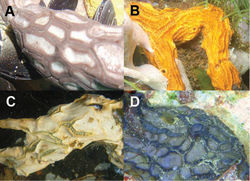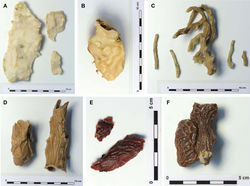Placospongia
| Notice: | This page is derived from the original publication listed below, whose author(s) should always be credited. Further contributors may edit and improve the content of this page and, consequently, need to be credited as well (see page history). Any assessment of factual correctness requires a careful review of the original article as well as of subsequent contributions.
If you are uncertain whether your planned contribution is correct or not, we suggest that you use the associated discussion page instead of editing the page directly. This page should be cited as follows (rationale):
Citation formats to copy and paste
BibTeX: @article{Becking2013ZooKeys298, RIS/ Endnote: TY - JOUR Wikipedia/ Citizendium: <ref name="Becking2013ZooKeys298">{{Citation See also the citation download page at the journal. |
Ordo: Hadromerida
Familia: Placospongiidae
Name
Placospongia Gray, 1867 – Wikispecies link – Pensoft Profile
Type species:
Placospongia melobesioides Gray, 1867 by monotypy
Description, amended from Systema Porifera (Hooper and van Soest 2002[1])
Encrusting to branching growth forms. Small encrustations of 3 cm2 to large surfaces of >2m2 to branching individual with total size of up to 45cm in length and branch diameter between 0.25-1.5cm. Total size of specimens is hard to establish as parts of the body may be encrusting within cracks. Dried material is hard, alcohol preserved and live specimens remain compressible as the choanosome is of more pliant material than the cortex. The surface is made up of smooth cortical plates separated by contractible grooves which form a kind of network on the surface while these are firmly closed in preserved specimens. See Vosmaer and Vernhout (1902)[2] and Rützler (2002)[3] for an extensive description of the genus. In live specimens grooves are open and oscules are visible inside contractile ridges, running between plates. Live color white, cream, orange, reddish brown to dark black-brown (Fig. 1, 2) and come color is usually retained after alcohol preservation. The contact lines between the plates ridge up slightly and are generally a different shade of the color of the plates.
Skeleton. The cortical plates consist of densely packed selenasters and can also contain auxiliary microscleres. Developmental stages of selenasters occur throughout the choanosome. Tylostyle tracts support the margins of the cortical plates. In branching specimens radial tylostyle tracts run from the centre core (consisting of densely packed selenaster) to the cortical plates, in encrusting specimens tracts run in direction from substrate to cortex. The sharp ends of the smaller tylostyles are projected beyond the cortex surface. Microscleres occur in the cortex and scattered in choanosomal skeleton. For a detailed description of external morphology and anatomy see Vosmaer and Vernhout (1902)[2].
Spicules. Megascleres are tylostyles in two size classes, microscleres are selenasters, and can include choanosomal and ectosomal spirasters (slender-spined streptasters and acanthose microrhabds), spherasters, and/or spherules. Selenasters often remain pigmented after treatment with bleach or nitric acid.
Taxon Treatment
- Becking, L; 2013: Revision of the genus Placospongia (Porifera, Demospongiae, Hadromerida, Placospongiidae) in the Indo-West Pacific ZooKeys, 298: 39-76. doi
Other References
- ↑ Hooper J, Van Soest R (2002) Systema Porifera. A guide to the classification of sponges. Volume 1. Kluwer Academic/ Plenum Publishers: New York, Boston, Dordrecht, London, Moscow.doi: 10.1007/978-1-4615-0747-5
- ↑ 2.0 2.1 Vosmaer G, Vernhout J (1902) The Porifera of the Siboga-Expedition. I. The genus Placospongia. In: Weber M (Ed). Siboga-Expeditie. Uitkomsten op zoologisch, botanisch, oceanographisch en geologisch gebied verzameld in Nederlandsch Oost-lndië 1899–1900aan boord H.M. ‘Siboga’ onder commando van Luitenant ter Zee 1e kl. G.F. Tydeman. 9 (Monographie VIa) Brill EJ, Leiden: 1-17.
- ↑ Rützler K (2002) Family Placospongiidae Gray, 1867. In: Hooper JNA, van Soest RW M (Ed.) Systema Porifera. A guide to the classification of sponges. 1 (Kluwer Academic/ Plenum Publishers: New York, Boston, Dordrecht, London, Moscow), Pp. 196–200.doi: 10.1007/978-1-4615-0747-5_21
Images
|

